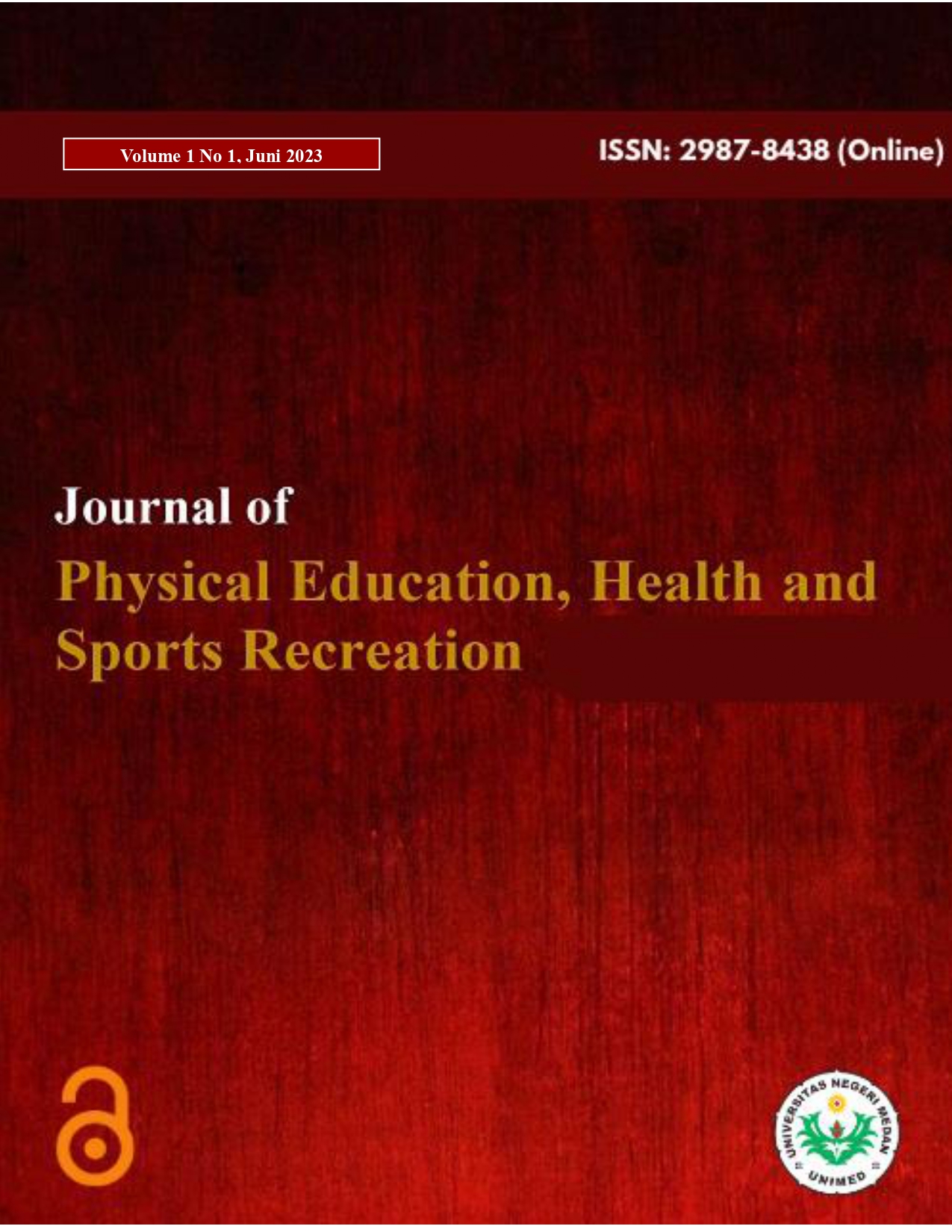PHYSICAL FITNESS VALUE OF STUDENTS OF PRIVATE JUNIOR HIGH SCHOOL BHAYANGKARI 2 KABANJAHE
DOI:
https://doi.org/10.24114/jpehsr.v1i1.46443Keywords:
Student Physical FitnessAbstract
This study aims to determine the level of physical fitness of students at Private Middle School Bhayangkari 2 Kabanjahe. This research was conducted at the Samura sports stadium. Data collection was carried out in October. The method used in this research is descriptive method by conducting tests and measurements. The test used was the Indonesian Physical Fitness Test for Junior High Schools, aged 13-15 years with a total sample of 40 people whose determination was based on purposive sampling. The results of this study did not find a level of physical fitness Very Good or 0.00%, nor found a level of physical fitness Good or 0.00%, in the moderate category there were 11 students or 27.50%, in the Less category there were 27 students or 67.50 %, in the Less Once category there are 2 students or 5.00%. Overall, the physical fitness level of the students of SMP PRIVATE BHAYANGKARI 2 KABANJAHE is 12.23 in the less category.References
Aisyah Trees Sandy, Anang Kadarsah, dkk (2020) œDibalik Wabah Covid - 19, Polita Press.
Albertus Fenanlampir&Muhamad Muhyi, (2015) Tes Dan Pengukuran Dalam Olahraga, CV andi offset
Danang Insita, dkk (2020) Pedoman Umum Menghadapi Pandemi Covid “ 19 Bagi pemerintah Daerah Pencegahan, Pengendalian, Diagnosis Dan Manajemen, Kemendagri.
Sepdianus, dkk (2019) œTes Dan Pengukuran Olahraga, Rajawali press.
H.Y.S. Santosa Griwijoyo, Dikdik Zafar, (2010) œKonsep Dan Cara Penilaian Kebugaran Jasmani Menurut Sudut Pandang Ilmu Faal OlahragaJurnal KepelatihanOlahraga.Vol.2. No.1.
Almira, D., Universitas, S., & Malang, N. (2019). Survei Tingkat Kebugaran Jasmani di Sekolah Menengah Pertama. 1(2), 132“138.
Iswandi, M. S. (2019). Siswa Smanko Sulawesi Selatan Survey of the Smanko Student ™ S Physical Fitness in South Sulawesi Muh . Setio Iswadi Program Studi S1 Jurusan Penjaskesrek.
Jasmani, K., Remaja, P., & Kelas, S. (2017). Faktor-Faktor Yang Berhubungan Dengan Kebugaran Jasmani Pada Remaja Siswa Kelas Xi Smk Negeri 11 Semarang. Jurnal Kesehatan Masyarakat (e-Journal), 5(3), 77“86.
Permana, R. (2016). Penguasaan Rangkaian Tes Kebugaran Jasmani Indonesia (TKJI) Melalui Diskusi dan Simulasi. Jurnal Refleksi Edukatika, 6(2), 119“129. https://jurnal.umk.ac.id/index. php/RE/article/download/603/617
Rochman, B., Indahwati, N., & Priambodo, A. (2020). Identifikasi Keterlaksanaan Pembelajaran PJOK Tingkat SMP Di Masa Pandemi Covid 19 Se-Kabupaten Sidoarjo. Jurnal Ilmiah Mandala Education, 6(1), 257“265. https://doi.org/10.36312/jime.v6i1.1343
Rozi, F., Rahma Safitri, S., Latifah, I., & Wulandari, D. (2021). Tiga Aspek dalam Pembelajaran Pendidikan Jasmani pada Masa Pandemi Covid-19. Jurnal Kependidikan: Jurnal Hasil Penelitian Dan Kajian Kepustakaan Di Bidang Pendidikan, Pengajaran Dan Pembelajaran, 7(1), 239. https://doi.org/10.33394/jk.v7i 1.3220
Septian Raibowo, & Yahya Eko Nopiyanto. (2020). Proses Belajar Mengajar Pjok Di Masa Pandemi Covid-19. STAND: Journal Sports Teaching and Development, 1(2), 112“119. https://doi.org/10.36456/jstand.v1i2.2774
Sinelnikov, O. a, Hastie, P. a, & Prusak, K.a. (2004). Situational Motivation during Seasons of Sport Education. Situational Motivation, 2(1), 43“47.
Studi, P., Jasmani, P., & Dan, K. (2016). Physical Fitness Level of Smpn 1 Bangko Students Rokan Hilir District.
Sudiana, I. K. (2014). Peran Kebugaran Jasmani bagi Tubuh. Seminar Nasional FMIPA UNDIKSHA IV, 389“398. https://ejournal.undiksha.ac.id/ index.php/semnasmipa/article/download/10507/6718
Wallhead, T., Garn, A. C., Vidoni, C., & Youngberg, C. (2013). Game play participation of amotivated students during sport education. Journal of Teaching in Physical Education, 32(2), 149“165. https://doi.org/10.1123/jtpe.32. 2.149
Downloads
Published
Issue
Section
License
Copyright (c) 2023 Join Marshelindo Barus, Ibrahim Ibrahim

This work is licensed under a Creative Commons Attribution-ShareAlike 4.0 International License.
Authors who publish with this journal agree to the following terms:
Authors retain copyright and grant the journal right of first publication with the work simultaneously licensed under a Creative Commons Attribution License that allows others to share the work with an acknowledgment of the work's authorship and initial publication in this journal.
Authors are able to enter into separate, additional contractual arrangements for the non-exclusive distribution of the journal's published version of the work (e.g., post it to an institutional repository or publish it in a book), with an acknowledgment of its initial publication in this journal.
Authors are permitted and encouraged to post their work online (e.g., in institutional repositories or on their website) prior to and during the submission process, as it can lead to productive exchanges, as well as earlier and greater citation of published work (See The Effect of Open Access).
This work is licensed under a Creative Commons Attribution-ShareAlike 4.0 International License.

